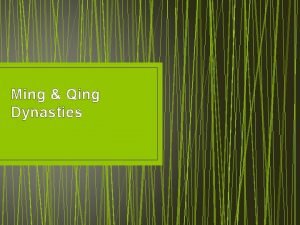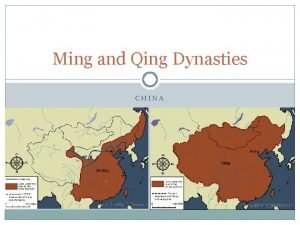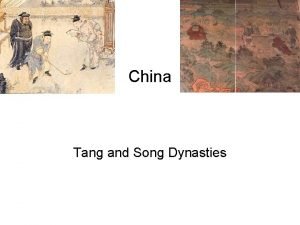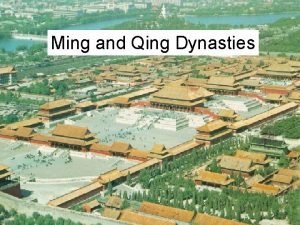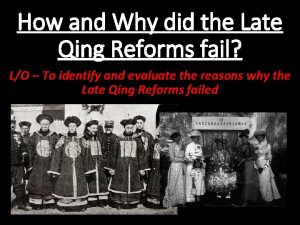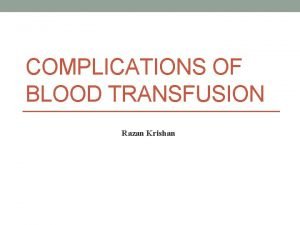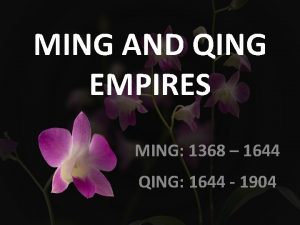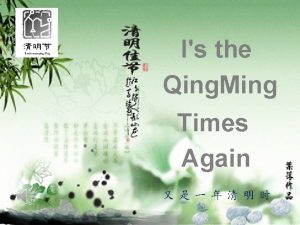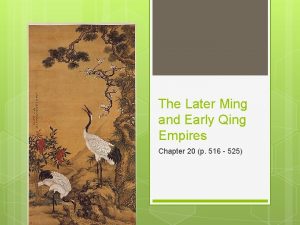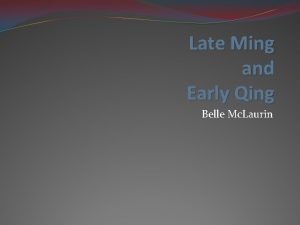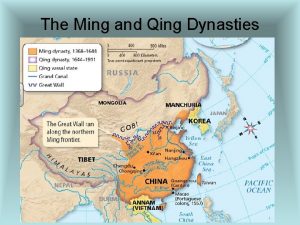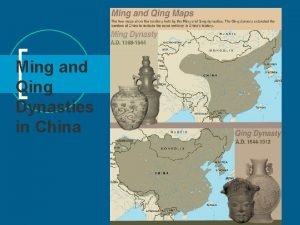The Late Ming and Early Qing Empires Hayden











- Slides: 11

The Late Ming and Early Qing Empires Hayden Nowell

The Ming Empire • The Ming empire thrived before the 1500’s and continued during them, but then this time was followed by decades of warfare, rural woes, and political weakness. • A few of their emperors that will be mentioned are Hongwu, Zhu Yunwen, and Yongle a. k. a Zhu Di.

Foreign Trade for Dayzzzz • • • In 1500 Hongwu outlawed foreign trade and had a isolationist policy, but shortly after they agreed to trade again so the Ming empire became heavily reliant on foreign trade. Emperor Yongle (Zhu Di) overtook Hongwu’s grandson and became ruler. He then built a huge fleet and reversed Hongwu’s policy and sent the fleet to collect tribute and trade. The merchant class became more powerful and prospered more because of this. All of their fortunes were based on foreign trade. The Ming stopped sending fleets out to the west so the western Europeans came to them to trade and teach Christianity. They were very prosperous about 70 years before their fall because of the wealth boom they had from foreign trade.

The Fall of the Ming Empire • • • The Ming empire was originally very prosperous and had strong leaders, but as they neared the end there came about rebellions and natural disasters that contributed to the fall. There was a period of cold and dry climate, the economy was in shambles, and the people believed they had lost the Mandate of Heaven. The ruling court was ineffectual which means…they sucked.

Natural Disasters • • • The first natural disaster was an earthquake. It is thought to have been the deadliest earthquake in history killing 800, 000 people. It killed 30% of the people in Xi’an (their capital). There was an unusually large amount of earthquakes during the early 1600’s, which was the later years of the Ming. The Little Ice Age caused great famine in the land. Connected to the Little Ice Age were large floods that hurt the Ming. Plague…not really a natural disaster. Oh well. The bubonic plague (fleas on rats, fleas on rats) struck in 1641 and while the exact number of deaths is unknown, it is said that 90% of the people in one area of the Ming empire died.

Other Crises • • A Japanese Shogun tried to conquer the Ming twice, and even though it was a failed attempt, it was still pretty costly for the Ming. The court had to pay 26, 000 ounces of silver for it. Some eunuchs and an emperor named Wei Zhongxian were bad rulers. The court under them couldn’t make good policies. Basically they just misruled big time. The empire faced a monetary crisis when there was fighting between the Spanish, Dutch, and English. This disrupted the flow of foreign money because the Spanish tried to send silver to the Americas rather than export it to the Ming empire. Rebellions also contributed to the fall. Peasants rebelled because they didn’t get enough food and couldn’t pay their taxes.

The Qing Empire • • The Qing empire was the last dynastic empire to rule the region. Like most empires, the Qing had powerful rulers at the beginning, a prosperous period in the middle, and rebellions, natural disasters, and sucky rulers at the end.

Early days • • • With the dissipation of the Ming, (wait for it) the Mongols *cue Mongaltage* and the Jurchens attacked because its easier to attack a crumbling empire than a whole one. Duh. The Qing was comprised of the Mongols and the Jurchens, and they were called the Manchus. The Jurchen ruling families intermarried with the Mongol ruling families. The Jurchen then subjugated the Mongols and absorbed their troops.

Nurhaci • • • Nurhaci was the Jurchen ruler who started all this. He actually used some of Genghis Khan’s policies, like utilizing knowledge and manpower of the people he conquered instead of just killing them. The Mongolian cavalry he absorbed really strengthened his army because the Mongols were beast. He overtook the Ming city, Shenyang, and made it his capital. He kept some of the Qing officials because they were experienced. Later he built an imperial palace in Shenyang.

Hung Taiji • • Nurhaci’s son, Hung Taiji, was his successor. He continued the attack on the Ming and went further than his father in placing Ming officials in powerful positions. In 1635, the Mongolian ruling court presented him with the imperial seal of the Yuan Empire which helped a lot with him trying to take over the Ming. His empire was called the Later Jin, and then later he renamed it the Qing. Thus, the Qing empire was born. • That was the early days so I hope this is ok. • • •

Works Cited • http: //www. chinahighlights. com/travelguide/china-history/the-ming-dynasty. htm
 Ming and qing dynasty
Ming and qing dynasty Ming empire
Ming empire Ming and qing dynasty venn diagram
Ming and qing dynasty venn diagram Qing qing hardware contacts
Qing qing hardware contacts Qing conquest of the ming
Qing conquest of the ming Qing conquest of the ming
Qing conquest of the ming Difference between maritime and land based empires
Difference between maritime and land based empires Late qing reform
Late qing reform Early empires in the ancient near east
Early empires in the ancient near east Early wood and late wood
Early wood and late wood Roots method of vegetative propagation
Roots method of vegetative propagation Early and late complications of blood transfusion
Early and late complications of blood transfusion
